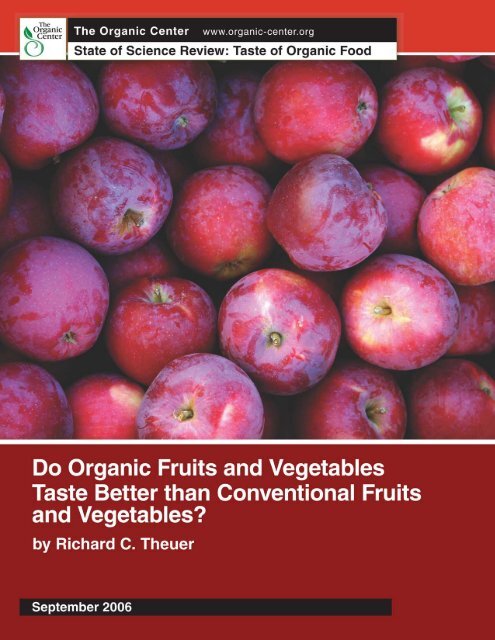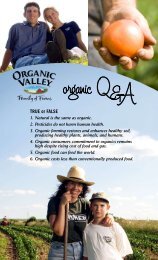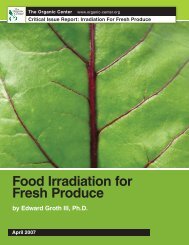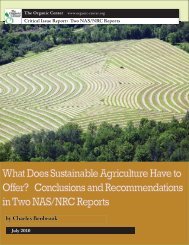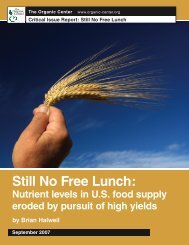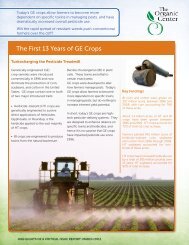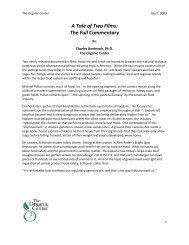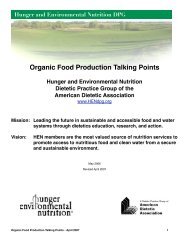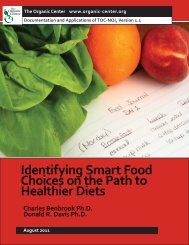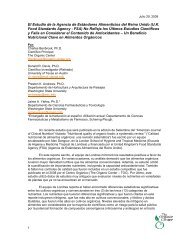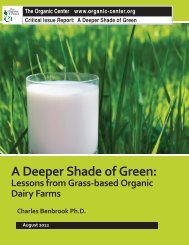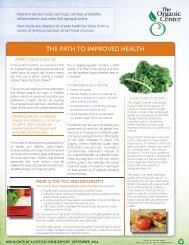Organoleptic Quality? - The Organic Center
Organoleptic Quality? - The Organic Center
Organoleptic Quality? - The Organic Center
Create successful ePaper yourself
Turn your PDF publications into a flip-book with our unique Google optimized e-Paper software.
Taste of <strong>Organic</strong> Food <strong>The</strong> <strong>Organic</strong> <strong>Center</strong><br />
I. FOCUS STATEMENT<br />
This State of the Science Review attempts to answer thw question “Do organic fruits<br />
and vegetables taste better than conventional fruits and vegetables?”. <strong>The</strong>re are<br />
several reasons why this question should be addressed.<br />
First, 43% of consumers of organic food give “better taste” as a major reason for<br />
purchasing organic fruits and vegetables (MORI Poll 2001, cited by Heaton (Heaton,<br />
2001)). It is important to know if the consumer conviction of “better taste” is due<br />
solely to the “halo effect” 1 of the organic label, and, if not, what accounts for the<br />
often-cited claim that organic produce tastes better.<br />
Second, the levels of some phenolic compounds are known to be higher in organic fruits and vegetables<br />
(Benbrook, 2005). Plants create phenolic compounds for many reasons, but a major reason is to make plant<br />
tissues less attractive to herbivores, insects, and other predators. Some phenolic compounds actually taste<br />
bad (Drewnowski and Gomez-Carneros, 2000; Lesschaeve and Noble, 2005). <strong>The</strong> bitter taste and the tactile<br />
sensation of astringency in tea, cider, red wine, and chocolate are caused primarily by the flavonoid phenolics,<br />
including flavanols and flavonols (Lesschaeve and Noble, 2005). <strong>The</strong>se phenolic compounds, like those in red<br />
grapes, are often responsible for the unique flavor of certain fruits. Accordingly, it is important to sort out<br />
if higher levels of phenolic compounds affect the taste of organic fruits and vegetables when compared to<br />
conventionally grown produce.<br />
What Is “<strong>Organoleptic</strong> <strong>Quality</strong>?”<br />
<strong>The</strong> dictionary defines “organoleptic” as “of or pertaining to the sensory properties of a particular food or<br />
chemical.” <strong>Organoleptic</strong> quality includes the typical sensory properties of a food: its taste, appearance and<br />
color, aroma, size and firmness, and even sound (e.g., the “snap” or “crack”<br />
when biting into a crisp apple). But organoleptic measures also include mouth<br />
feel and any other sensations related to eating a food.<br />
<strong>The</strong> term organoleptic quality is used broadly in this document to include<br />
storage properties (“storability”), since many fruits and vegetables are stored<br />
for various periods of time to enable “non-seasonal” retail availability. Clearly,<br />
produce that stores well will be more appealing to consumers than fruit with<br />
visible blemishes, soft spots, or lack of flavor. <strong>Organic</strong> cultivation practices can<br />
influence storability and thus alter the organoleptic qualities of produce at the<br />
point of sale and consumption.<br />
1 “Halo effect” is the term used to describe cognitive bias that arises when information about one quality<br />
attribute of a product serves to influence and bias the judgment of its other qualities.
Taste of <strong>Organic</strong> Food <strong>The</strong> <strong>Organic</strong> <strong>Center</strong><br />
Third, many sellers, distributors, and promoters of organic foods claim that organic foods taste better. When<br />
such assertions are included in advertising and promotional literature, they must comply with federal rules<br />
governing marketing claims and must be backed up by credible scientific evidence. As the organic industry<br />
moves toward more direct claims regarding comparative taste in advertising and product labeling, it will<br />
be essential to support such claims with a strong body of evidence from carefully designed and controlled<br />
experiments. Lacking such evidence, the industry will be vulnerable to critical investigations by government<br />
agencies and possible erosion in consumer confidence.<br />
<strong>The</strong>re actually are several ways that this “simple” question – Do organic fruits and vegetables taste better than<br />
conventional produce? – can be interpreted and answered.<br />
• Does a fruit or vegetable labeled “organic” receive higher organoleptic scores than the “same” fruit or<br />
vegetable not so labeled?<br />
• Do fruits and vegetables collected from organic markets receive higher organoleptic scores than the<br />
“same” fruits and vegetables collected from conventional grocery stores?<br />
• Do fruits and vegetables grown organically in a certain geographical and climatic area have higher<br />
organoleptic scores than the “same” fruits and vegetables grown conventionally in the same<br />
geographical and climatic area?<br />
• Do fruits and vegetables grown by different cultural practices show distinctive differences in<br />
organoleptic quality and, if so, to which specific factors and cultural practices can these differences be<br />
attributed?<br />
While seemingly similar, these questions are in fact quite different. <strong>The</strong> purpose of this State of the Science<br />
Review is to help readers interpret the published literature on the comparative organoleptic characteristics of<br />
organic foods in the context of the questions posed above.
Taste of <strong>Organic</strong> Food <strong>The</strong> <strong>Organic</strong> <strong>Center</strong><br />
II. METHODS USED TO COMPARE ORGANOLEPTIC FOOD QUALITY<br />
About a dozen reviews published in the past two<br />
decades have summarized primary research reports<br />
of the comparative sensory characteristics of organic<br />
and conventional foods. <strong>The</strong> primary reports date<br />
back as far as the middle of the Twentieth Century.<br />
Since both organic and conventional agricultural<br />
practices have evolved over the past fifty years,<br />
several of these reviews are especially useful because<br />
the authors critically evaluated the relevance, validity,<br />
and context of the primary research. For example,<br />
the Soil Association report of 2001 authored by<br />
Heaton pays close attention to cultivation methods<br />
to ensure that foods described as “organic” meet<br />
current “certified organic” standards (e.g., three<br />
years of organic management of the land) (Heaton,<br />
2001). <strong>The</strong> classification of the types of comparisons<br />
of organically and conventionally produced foods<br />
described by Woese et al. continues to facilitate<br />
critical analysis and enable<br />
unbiased conclusions (Woese et<br />
al., 1997).<br />
This State of the Science Review<br />
summarizes these reviews<br />
and adds the results of more<br />
recent primary research on<br />
the comparative organoleptic<br />
characteristics of organically and<br />
conventionally cultivated fruits<br />
and vegetables.<br />
Measuring and describing the<br />
organoleptic characteristics of<br />
a food are much more difficult<br />
than measuring and describing<br />
its levels of specific chemical and<br />
nutritional components. In the<br />
future it may become routine<br />
to use an “electronic nose” to provide objective<br />
and quantitative data (Müller et al., 2003) but this<br />
methodology is not yet well established.<br />
Heaton offered the following partial list of<br />
“difficulties” with published research on taste<br />
(Heaton, 2001).<br />
• Cooking. Taste differences in one study were<br />
found in raw carrots but not when the carrots<br />
were cooked (Rembialkowska, 2000).<br />
• Ripeness. An agriculturally valid study<br />
that reported inconsistent or not significant<br />
differences between organic and conventional<br />
fruits and vegetables found that taste was<br />
more dependent on the level of ripeness or<br />
maturity of the samples (which had not been<br />
fully controlled) (Basker, 1992).<br />
• Subjectivity. Taste is a personal thing and<br />
individual preferences vary.<br />
• Preconceptions. Consumer may have<br />
preconceived notions about the superior taste<br />
of organic produce (i.e., the “halo effect”)<br />
(Hansen, 1981).<br />
Other “complications” include:<br />
• Peeling. A preference for organic potatoes<br />
disappeared when the cooked potato sections<br />
were peeled (Wszelaki et al., 2005).<br />
• Variety. Differences in choices of cultivars<br />
between the two systems might explain<br />
differences in taste (Heaton, 2001).<br />
Taste panel composition.<br />
Trained panelists typically provide<br />
more consistent and objective data<br />
han untrained tasters, yet studies<br />
ften do not clearly explain whether<br />
panels are trained, and if so, how and<br />
o what degree.<br />
<strong>The</strong> significance of these “difficulties”<br />
nd “complications” can be best<br />
xemplified by analyzing the<br />
uestions posed above.<br />
Question: Does a fruit or vegetable<br />
abeled “organic” receive higher<br />
rganoleptic scores than the “same”<br />
fruit or vegetable not so labeled?<br />
<strong>The</strong> answer to this question is,<br />
generally, YES. Experimental research indicates<br />
that labeling a food as “organic” increases the<br />
consumer acceptability of the food. As indicated<br />
above, “halo effect” is the term used to describe<br />
cognitive bias that arises when information<br />
about one quality attribute of a product serves<br />
to influence and bias the judgment of its other<br />
qualities.<br />
Providing information about cultivation method affects<br />
consumer preferences for organic versus conventional<br />
vegetables (Johansson et al., 1999; Schutz and<br />
Lorenz, 1976). In both studies, products labeled as<br />
organic generally showed increases in preference<br />
scores. In taste tests using identical tomatoes with<br />
different labels, consumers perceived taste differences<br />
based on the labeling alone (Alvensleben and Meier,
Taste of <strong>Organic</strong> Food <strong>The</strong> <strong>Organic</strong> <strong>Center</strong><br />
Question: Do fruits and vegetables collected from<br />
organic markets receive higher organoleptic scores<br />
than the “same” fruits and vegetables collected from<br />
conventional grocery stores?<br />
<strong>The</strong> answer to this question is SOMETIMES, but<br />
it is important not to generalize the results.<br />
Market-oriented supply studies attempt to answer<br />
this question from the perspective of the retail<br />
consumer. Typically, foods on sale in a given day<br />
are collected from shops selling organic food and<br />
other shops selling conventional food. Woese et<br />
al. pointed out the major limitation to this kind<br />
of study: the origin of the samples is unknown,<br />
and consequently information about growing<br />
conditions (climate, soil type, management<br />
practices, cultivars, etc.) is not available (Woese<br />
et al., 1997). Furthermore, the samples can differ<br />
in ripeness and variety, which can markedly affect<br />
several quality parameters.<br />
In a classic market-oriented supply study with all<br />
of the limitations described above, Bordeleau et<br />
al. compared specific internal and external quality<br />
parameters for organic and conventional Golden<br />
Delicious apples purchased in shops in Denmark<br />
(Bordeleau et al., 2002). <strong>The</strong> organic apples were<br />
grown in Italy and packaged in plastic bags in<br />
April 2002; the conventional apples were grown<br />
in France and packaged in cartons in March 2002.<br />
All the apples appeared to be of similar maturity<br />
when purchased but the date of purchase was not<br />
disclosed. No other cultural details were available.<br />
Obviously this comparison is highly relevant for<br />
the Danish consumer in the market at the time<br />
the samples were purchased, but it has limited<br />
value otherwise.<br />
Harker described his experience in apple<br />
marketing to support his contention that industry<br />
regulations and regulatory quality standards work<br />
to undermine the reliability of organic food claims<br />
substantiated by testing of samples intercepted in<br />
the marketplace (Harker, 2004).<br />
Market supply studies may become more<br />
scientifically defensible in the future. <strong>Organic</strong>ally<br />
produced foods have grown in popularity in<br />
the past few decades, are now subject to welldefined<br />
production standards, and have gained<br />
distribution in high-volume supermarkets. In<br />
many cases, organic produce has been picked<br />
at similar levels of ripeness, and processed and<br />
marketed in systems similar to conventional<br />
produce. Indeed, some farms are growing organic<br />
and conventional produce on the same types of<br />
farmland, are planting and harvesting at about<br />
the same time, and are handling produce in<br />
similar ways. Both organic and conventionally<br />
produced fruits and vegetables must adhere to<br />
the retailer’s internal quality standards. Future<br />
market-based supply studies will provide more<br />
reliable comparative data to the extent that<br />
quality control, regulatory, and certification<br />
programs enhance the traceability of both organic<br />
foods and conventional foods to their source and<br />
allow access to more detailed information on<br />
where and how the food was produced, stored,<br />
and shipped to retail markets.
Taste of <strong>Organic</strong> Food <strong>The</strong> <strong>Organic</strong> <strong>Center</strong><br />
Question: Do fruits and vegetables grown organically<br />
in a certain geographical and climactic area have<br />
higher organoleptic scores than the “same” fruits<br />
and vegetables grown conventionally in the same<br />
geographical and climatic area?<br />
<strong>The</strong> answer to this question also is SOMETIMES,<br />
but it is important to make sure that the tested<br />
samples are well matched.<br />
Woese et<br />
al. offered<br />
the following<br />
critique of these<br />
kinds of surveys<br />
(Woese et al.,<br />
1997). Products<br />
are taken from<br />
selected organic<br />
farms, and<br />
neighboring<br />
conventional or<br />
integrated farms<br />
are chosen in<br />
order to make<br />
sure that the<br />
climate and<br />
weather are<br />
the same and<br />
that soil types<br />
are reasonably<br />
matched. Even<br />
when weather<br />
and soil type<br />
are properly matched, other differences may<br />
exist, such as plant genetics, the effectiveness of<br />
irrigation practices, and harvest timing. For these<br />
reasons, it is difficult to select truly matched-pairs<br />
of organic and conventionally farmed fields where<br />
the differences in organoleptic food quality can<br />
be attributed solely to the unique characteristics<br />
of organic production. Nonetheless, this<br />
experimental design is currently the best available<br />
for evaluating differences between organic and<br />
conventional foods.<br />
Scientists from Washington State University (WSU) pick strawberries, in 2005, for<br />
a study comparing organic and conventional fruit quality.<br />
Most published surveys of this type provide<br />
limited information on soils, climate, and<br />
farming systems and the accuracy of reported<br />
information typically cannot be verified. Many<br />
published survey studies were found to be<br />
agriculturally invalid (Heaton, 2001). An organic<br />
system must be in place for three years to build<br />
the soil and achieve “organic” status. Heaton<br />
considered invalid those studies that combined<br />
the crop results from two years of transition with<br />
those from the first year of certifiable organic<br />
stewardship.<br />
Question: Do fruits and vegetables grown by<br />
different cultural practices show distinctive differences<br />
in organoleptic quality and, if so, to which specific<br />
factors and cultural practices can these differences be<br />
attributed?<br />
Cultivation tests and field trials are the most<br />
effective means of learning the effects of<br />
specific cultural practices. Cultivation tests try to<br />
determine whether there is a linkage between<br />
a given farming<br />
practice and<br />
one or more<br />
organoleptic<br />
qualities. In such<br />
studies, scientists<br />
usually alter only<br />
one variable at a<br />
time, in the hope<br />
that such a study<br />
design will make it<br />
possible to isolate<br />
specific linkages.<br />
Cultivation<br />
tests attempt<br />
to determine<br />
whether food<br />
harvested from<br />
different forms<br />
of production<br />
show distinctive<br />
differences in<br />
organoleptic<br />
quality and, if so,<br />
which factors and production methods account<br />
for these differences. Nonetheless, Woese et al.<br />
expressed some valid reservations about these<br />
kind of studies (Woese et al., 1997). For example,<br />
the results of these studies only apply to specific<br />
locations and specific management practices,<br />
although some generalizations may be justified.<br />
It is important to remember that there is<br />
considerable diversity within organic management<br />
systems and that an organic farmer’s level of<br />
skill and experience often plays a large role<br />
in food product quality. In addition, different<br />
situations and different production seasons can<br />
require different practices. Different practices can<br />
have specific effects on food quality. Likewise,<br />
conventional management practices also have<br />
evolved over the years, and continue to do<br />
so, and include more and more sustainable<br />
and eco-friendly practices. Experience and<br />
skill levels also matter greatly on conventional<br />
farms. For example, data compiled by the U.S.<br />
Department of Agriculture’s Economic Research
Taste of <strong>Organic</strong> Food <strong>The</strong> <strong>Organic</strong> <strong>Center</strong><br />
An organic tomato farm in Taiwan uses an advance trellis<br />
system to assure good air movement throughout the crop<br />
canopy, in order to reduce plant disease losses. Such trellis<br />
systmes can also impact taste by altering the solar radiation<br />
reaching fruits.<br />
Service (ERS) show that for many crops, the<br />
most successful 10% of farmers have per bushel,<br />
or per unit, production costs one-third or less<br />
than the costs on the 10% of farms with the<br />
highest cost structures (ERS, 2004). ERS points<br />
to management skills and experience as one of<br />
the most important factors driving differences<br />
in costs. Management skill and experience is<br />
probably even more important on organic farms<br />
than conventional ones, since organic farms<br />
depend so heavily on a host of farming-systembased<br />
preventive practices, while conventional<br />
farmers tend to rely more heavily on the purchase<br />
of off-farm inputs to deal with pests or soil<br />
fertility-related production problems.<br />
We think of the taste of food as being something<br />
that only we humans can appreciate. However,<br />
several studies have used experimental animals<br />
as the “tasters”, by giving hens, rats, or mice freechoice<br />
access to organic foods and conventionally<br />
grown foods and measuring how much of each type<br />
of food they consume. Woese et al. concluded from<br />
their review of food consumption behavior studies<br />
that “animals distinguish between the foods on offer<br />
from the various agricultural systems and almost<br />
exclusively prefer organic produce” (Woese et al.,<br />
1997).
Taste of <strong>Organic</strong> Food <strong>The</strong> <strong>Organic</strong> <strong>Center</strong><br />
III. LITERATURE REVIEWS ON THE COMPARATIVE TASTE OF ORGANIC AND<br />
CONVENTIONAL FOODS<br />
In a widely cited study conducted in the late<br />
1980s in Israel, Basker used tasters who had<br />
some experience in taste panel procedures in the<br />
hope of minimizing panelist subjectivity (Basker,<br />
1992). Overall, he produced 460 assessments of<br />
29 samples covering five organic and conventional<br />
fruits and four vegetables. In the end, he found no<br />
significant pattern of preference between organic<br />
and conventional products. However, after analysis,<br />
he discovered that the fruits and vegetables were<br />
not all at the same stage of ripeness, which might<br />
seriously affect their taste, and thus the results of<br />
the experiment. In addition, scant information was<br />
reported regarding the source or production systems<br />
used to grow the foods included in this study. Hence<br />
it is not known how representative these foods were<br />
of high quality organic or conventional foods.<br />
Samples of conventional and organic strawberries ready<br />
for a taste panel at Washington State University. Panels<br />
in both 2005 and 2006 preferrred the organic strawberries<br />
over the conventionally-grown fruit.<br />
Woese et al. published an extensive literature review<br />
for the German Federal Institute for Consumer<br />
Health Protection and Veterinary Medicine in which<br />
they summarized and evaluated the results from<br />
more than 150 investigations comparing the quality<br />
of conventionally and organically produced food,<br />
or of foods produced with the aid of different<br />
fertilization systems (Woese et al., 1995). In 1997, a<br />
comprehensive summary of this work was published<br />
in an English language journal (Woese et al., 1997).<br />
Most of the studies evaluated were investigations<br />
of concentrations of desirable and undesirable<br />
ingredients, pesticide residues, and contaminants,<br />
sensory analyses, and feed experiments with animals.<br />
Nutritional studies in humans were reviewed, as were<br />
novel, holistic methods of analysis (for example,<br />
the ascending-imaging method, copper chloride<br />
crystallization and ultraweak photon emissions; these<br />
methods are not generally used or understood by U.S.<br />
scientists).<br />
Despite great variability in the types of studies<br />
reviewed, some quality differences in food produced<br />
using conventional and organic farming methods<br />
were identified (Woese et al., 1997). <strong>The</strong>se quality<br />
differences include a lower protein content in organic<br />
wheat, leading to an undesirable impact on baking<br />
quality; a desirable trend toward higher Vitamin C<br />
and lower nitrate values in organic potatoes related to<br />
use of manure rather than mineral fertilization; much<br />
lower nitrate levels in organic leaf, root, and tuber<br />
vegetables; and higher dry matter and a trend toward<br />
slightly more Vitamin C, particularly in leaf vegetables<br />
(lettuce, cabbage, spinach, and chard). <strong>The</strong>re was no<br />
clear trend in sensory properties between organic and<br />
conventional vegetables. However, food preference<br />
Figure 1. <strong>Organic</strong> compared to conventional crops. Percent difference in nutrient<br />
content, selected nutrients. V. Worthingon, 1998
Taste of <strong>Organic</strong> Food <strong>The</strong> <strong>Organic</strong> <strong>Center</strong><br />
studies in several species of animals (hens, mice, and<br />
rats) showed a significant and consistent preference<br />
for organic produce.<br />
Alföldi et al. summarized the published literature on<br />
differences between organic and other management<br />
systems (Alföldi et al., 1998). Of seven studies<br />
comparing taste with organic management versus<br />
conventional management, they judged that there<br />
was positive impact of organic management in two:<br />
apples in Austria (Velimirov et al., 1995) and potatoes<br />
in Finland (Varis et al., 1996). In the other five studies<br />
no differences were found.<br />
Worthington reviewed the<br />
literature produced over<br />
the last 50 years comparing<br />
the nutritional quality of<br />
organic with conventional<br />
crops (Worthington, 1998).<br />
She concluded that the<br />
evidence for nutritional<br />
superiority of organically<br />
versus conventionally<br />
grown crops based on<br />
nutrient content alone is suggestive, though not<br />
conclusive. An overall trend showed higher nutrient<br />
content in organically grown crops, possibly due to<br />
lower water content in organic crops. Only vitamin<br />
C and nitrates were clearly affected by fertilization<br />
method, with higher levels of vitamin C and lower<br />
levels of nitrates occurring in organically grown<br />
crops. Protein quality may be better in organically<br />
grown crops as well. Insufficient or conflicting data<br />
exist for other nutrients. Evidence from farm animals<br />
and controlled animal feeding studies strongly<br />
suggested that organically grown crops are superior<br />
to conventionally grown crops for promoting health.<br />
Worthington did not address taste or other sensory<br />
characteristics.<br />
Worthington surveyed existing literature comparing<br />
nutrient content of organic and conventional<br />
crops, using a unique statistical approach to<br />
identify significant differences and trends in the<br />
data (Worthington, 2001). Published comparative<br />
measurements of organic and conventional nutrient<br />
content were entered into a database for calculation.<br />
For each organic-to-conventional comparison,<br />
a percent difference was calculated: (organic<br />
- conventional)/conventional x 100. For nutrients<br />
where there were adequate data, the Wilcoxon<br />
signed-rank test was used to identify statistically<br />
significant differences in nutrient content. For the<br />
most frequently studied vegetables, mean percent<br />
difference values were also calculated for each<br />
nutrient, by study and by vegetable. According to<br />
her analysis, which did not consider differences in<br />
moisture content, organic crops contained significantly<br />
more vitamin C, iron, magnesium, and phosphorus<br />
and significantly less nitrates than conventional<br />
crops. <strong>The</strong>re were non-significant trends showing less<br />
protein, but better quality protein in organic foods<br />
compared to conventional foods, as well as a higher<br />
content of nutritionally significant minerals and lower<br />
amounts of some heavy metals. Worthington did not<br />
review sensory data (Worthington, 2001).<br />
<strong>The</strong> Food and Agriculture Organization of the United<br />
Nations (FAO, 2000) summarized the sensory<br />
differences as follows: “Many sensory analysis studies<br />
have been carried out to investigate<br />
differences in selected organoleptic<br />
parameters between organically and<br />
conventionally grown products, and<br />
on the whole these indicate that there<br />
is no clear difference between the<br />
two (Conklin and Thompson, 1993;<br />
Woese et al., 1997). Certain studies<br />
have shown significant differences<br />
for selected products, as in the case<br />
of the sensory differences between<br />
organically and conventionally grown<br />
apples of the Golden Delicious variety. <strong>The</strong> organically<br />
grown apples were found to be firmer and received<br />
higher taste scores than conventionally grown apples.<br />
<strong>The</strong> content of flavanoids in the organic apples was<br />
higher (Weibel et al., 2000). Another study showed<br />
that organic tomatoes were sweeter and conventional<br />
carrots had more ‘carrot taste’ (Haglund and<br />
Johansson, 1995).”<br />
Brandt and Mølgaard examined possible differences<br />
between organic and conventional plant products,<br />
with emphasis on possible human health effects<br />
(Brandt and Mølgaard, 2001). <strong>The</strong>y concluded that<br />
nutritionally important differences relating to contents<br />
of minerals, vitamins, proteins and carbohydrates are<br />
not likely, primarily since none of these are deficient<br />
in typical First World diets, nor are present levels of<br />
pesticide residues in conventional products a cause<br />
for concern. However, they expressed their belief that<br />
contents of many plant defense-related secondary<br />
metabolites in the diet are lower than optimal for<br />
human health. <strong>The</strong>re is ample, but circumstantial,<br />
evidence that, on average, organic vegetables and<br />
fruits most likely contain more of these secondary<br />
metabolites than conventional ones. For a detailed<br />
analysis, see the <strong>Organic</strong> <strong>Center</strong>’s “State of Science<br />
Review” on antioxidants in organic and conventional<br />
foods (Benbrook, 2005). Thus it is possible that<br />
organic plant foods may in fact benefit human health<br />
more than the corresponding conventional ones. <strong>The</strong><br />
authors did not investigate taste effects, other than<br />
to mention that many secondary metabolites act as<br />
anti-nutrients that can retard growth and reduce the
Taste of <strong>Organic</strong> Food <strong>The</strong> <strong>Organic</strong> <strong>Center</strong><br />
bioavailability of nutrients in food.<br />
<strong>The</strong> Soil Association in the United Kingdom published<br />
two reports in 2001. Fookes focused on general<br />
allegations made against organic agriculture (which<br />
did not involve sensory quality of the foods) (Fookes,<br />
2001). Heaton’s review is relevant to this review and<br />
includes a specific section on taste (Section 3.4.3)<br />
(Heaton, 2001). According to Heaton:<br />
“Although differences in taste are difficult<br />
to confirm in controlled studies, of the<br />
six agriculturally valid studies reviewed<br />
here, five reported better taste qualities in<br />
organic produce:<br />
• Basker - Inconsistent and nonsignificant<br />
differences in the taste of nine<br />
different fruits and vegetables (Basker,<br />
1992).<br />
• Dlouhy - Better taste in organically<br />
grown, peeled potatoes after four months<br />
storage (Dlouhy, 1981).<br />
• Hogstad et al. - Better total flavour<br />
strength, sweet taste and sugar content in<br />
organically grown carrots (Hogstad et al.,<br />
1997).<br />
• Reganold et al. - <strong>Organic</strong>ally<br />
grown apples were sweeter and less tart<br />
(Reganold et al., 2001).<br />
• Rembialkowska - Taste and smell<br />
better in organically grown raw carrots and<br />
sauerkraut (cabbage) (Rembialkowska,<br />
2000).<br />
• Weibel et al. – ‘15 per cent better<br />
taste in organic apples’ (Weibel et al.,<br />
2000).”<br />
Kumpulainen reviewed the literature and found no<br />
taste difference in potatoes, lettuce, green beans,<br />
broccoli and spinach (Kumpulainen, 2001). He noted<br />
that most of the studies showing differences in flavor<br />
were studies of leafy vegetables.<br />
Bordeleau et al. reviewed sensory comparisons and<br />
earlier reviews of organic and conventional foods<br />
(Bordeleau et al., 2002). <strong>The</strong>y concluded that, in<br />
general, there is no trend of better taste in organic<br />
fruits or vegetables. In vegetables such as carrots,<br />
where high water content is preferred, organic<br />
vegetables may rate lower in preference tests.<br />
Bourn and Prescott provide a detailed and extensive<br />
analysis of the sensory qualities of organically and<br />
conventionally grown food (Bourn and Prescott,<br />
2002). After reciting the many issues with sensory<br />
evaluation techniques – discrimination tests,<br />
descriptive analysis techniques, and preference/<br />
acceptability measures – they concluded that there is<br />
yet to be convincing evidence that organic produce<br />
differs in sensory terms from conventional produce,<br />
let alone that there is any taste advantage.<br />
Tauscher et al. evaluated food produced by different<br />
methods and found a slight advantage for organically<br />
grown produce (Tauscher et al., 2003).
Taste of <strong>Organic</strong> Food <strong>The</strong> <strong>Organic</strong> <strong>Center</strong><br />
IV. NEW RESEARCH FINDINGS ON ORGANOLEPTIC FOOD QUALITY<br />
A number of studies have appeared in the literature<br />
in the last five years that provide new insights into<br />
differences in organoleptic food quality.<br />
Apples<br />
Weibel et al. (Weibel et al., 2000) analyzed Golden<br />
Delicious apples from five pairs of a biologic (organic)<br />
and a neighboring integrated fruit farm in Switzerland.<br />
<strong>Organic</strong> orchards were<br />
less than a kilometer<br />
away from the matched<br />
conventional orchard. No<br />
other details of production<br />
are described. <strong>Organic</strong><br />
apples had significantly<br />
firmer fruit flesh (14% at<br />
harvest; 12% higher after 40-43 days of cold storage)<br />
and 19% higher phenolic content (mainly flavanols)<br />
than integrated apples. Trained taste panelists gave<br />
organic apples 15% higher taste marks.<br />
Integrated production has essentially eliminated<br />
“conventional production” of fruit in Switzerland<br />
and now accounts for 94% of apple production.<br />
Five percent of Swiss apples are grown according to<br />
organic guidelines (Bertschinger et al., 2002). Four<br />
different apple varieties with three block replicates<br />
were produced in Switzerland under either organic<br />
or integrated management systems on a single plot<br />
of land. Yields and the proportion of apples meeting<br />
market quality standards were lower under organic<br />
management but the fruit was firmer, sweeter, and<br />
less acidic (Bertschinger et al., 2002).<br />
Reig et al. compared the quality of organically and<br />
conventionally grown Fuji and Golden Delicious apples<br />
in Lleida, Spain (Reig et al., 2006). No other details on<br />
the farms or management practices were disclosed.<br />
Golden Delicious apples were harvested at two<br />
different dates and the differences in total antioxidant<br />
activity were determined at harvest and related to<br />
the changes in color, firmness, acidity and soluble<br />
solids content (SSC). No differences in antioxidant<br />
activity were found between organic and nonorganic<br />
Golden Delicious apples at harvest. However,<br />
significant differences in quality were found. <strong>Organic</strong><br />
Fuji apples showed a significant increase in firmness,<br />
acidity, SSC, and were brighter and more yellow<br />
based on the readings from a HunterLab Colormeter.<br />
<strong>Organic</strong>ally grown Golden Delicious apples exhibited<br />
the same increases but only when the fruit were<br />
picked at a more mature stage (2nd harvest date). At<br />
both harvest dates, organic Golden Delicious apples<br />
were significantly less mature (lower starch index)<br />
than conventional Golden Delicious, but organic<br />
and conventional Fuji apples did not differ in terms<br />
of maturity. Collectively these results showed that<br />
organic management may delay on-tree fruit ripening<br />
and also improve fruit eating quality.<br />
Four apple cultivars were grown in experimental<br />
organic or integrated orchards at Debrecen University<br />
in Hungary (Róth et al., 2004). Acoustic stiffness (a<br />
non-destructive measure of firmness) was used to<br />
measure the same apples before and after six months<br />
of cold storage. <strong>The</strong>re were no significant differences<br />
between the growing systems. <strong>The</strong> Liberty cultivar, a<br />
scab-resistant cultivar popular for organic orchards,<br />
had the least change in firmness during storage.<br />
Róth et al. examined whether there was a difference<br />
in the quality (texture, taste, flavor) and post-harvest<br />
behavior of apples from integrated versus organic<br />
orchards in three different regions of Belgium (Róth<br />
et al., 2006). In each region organic and integrated<br />
orchards had the same climatic and soil capabilities.<br />
Apples were harvested at the end of September in<br />
2004 and stored in air and also under ULO (ultralow<br />
oxygen) conditions (1% O 2 , 2.5 % CO 2 ) for 6 months.<br />
Acoustic stiffness (firmness), soluble solids content,<br />
acid content, sugar content and the aroma profile<br />
were studied. <strong>Quality</strong> parameters were analyzed<br />
immediately after harvest and after storage. At both<br />
times an additional shelf-life experiment (14 days)<br />
was carried out, simulating retail store conditions.<br />
<strong>The</strong>re was a considerable softening during storage<br />
in air and a reduction in shelf-life, but not under<br />
controlled atmosphere conditions. Apples coming from<br />
different regions and different production systems<br />
did not differ in the studied parameters. Freshly<br />
harvested apples had high malic acid, quinic acid,<br />
and sucrose contents and were clearly different from<br />
stored apples that had high glucose and citric acid<br />
contents. Fresh apples had a different aroma profile<br />
compared with apples that had been on the shelf for<br />
14 days, except for air-stored apples immediately<br />
after storage. <strong>The</strong> volatile compound responsible for<br />
the typical apple aroma, (2-methylbutyl-acetate), had<br />
the highest relative abundance at harvest, after shelflife<br />
and storage in air. <strong>The</strong> authors concluded that the<br />
effect of storage condition is much greater than that<br />
of the production systems on the quality of apples.<br />
<strong>Organic</strong> management yielded sweeter and less<br />
tart Golden Delicious apples in Washington State<br />
compared with conventional and integrated systems.<br />
<strong>The</strong> apples were grown in four replicate plots for each<br />
management system in a randomized complete block
Taste of <strong>Organic</strong> Food <strong>The</strong> <strong>Organic</strong> <strong>Center</strong><br />
design (Reganold et al., 2001).<br />
Peck studied Gala apples grown during the ninth and<br />
tenth growing seasons under organic, integrated, or<br />
conventional management in the Yakima Valley of<br />
Washington State (Peck, 2004). <strong>Organic</strong> apples had 6-<br />
10 Newtons (a Newton -- “N” -- is a measure of force)<br />
units higher flesh firmness than conventional apples,<br />
and 4-7 N units higher firmness than integrated<br />
apples. Additionally, consumers consistently rated<br />
organic apples to be firmer and to have better<br />
textural properties. Few consistent results were<br />
found for fruit flavor as measured by soluble solids<br />
concentration or titratable acidity, and this was also<br />
reflected in consumer panels. <strong>The</strong>se Gala apples<br />
were slightly smaller in some years but were as firm,<br />
or firmer, and had consistently superior storability<br />
compared to conventionally grown apples (Peck et<br />
al., 2006). After six months of controlled atmosphere<br />
storage, only 10% of the organic apples failed to<br />
meet the minimum firmness standard, compared to<br />
36% of conventional management apples and 54% of<br />
integrated management apples.<br />
Bordeleau et al. compared specific internal and<br />
external quality parameters for organic and<br />
conventional Golden Delicious apples purchased<br />
in shops in Denmark (Bordeleau et al., 2002). <strong>The</strong><br />
conventional apples were 24% bigger, averaging<br />
156.5 mL in volume compared to 126.7 mL for the<br />
organic apples. Soluble solids (sugars, Brix) and acid<br />
levels did not differ significantly but the ratio of Brix<br />
to acid was slightly higher in the organic apples.<br />
<strong>The</strong>re was no difference in<br />
flesh firmness in this market<br />
survey.<br />
Strawberries<br />
Ecologically cultivated<br />
strawberries and<br />
conventionally cultivated strawberries were grown in<br />
adjacent plots in Spain under identical environmental<br />
conditions (Cayuela et al., 1997). <strong>The</strong> conventional<br />
plots had a 76% greater yield. <strong>The</strong> ecologically grown<br />
fruit had superior quality to the conventionally grown<br />
fruit, showing a more intense color, higher sugar<br />
and dry matter contents, and better organoleptic<br />
characteristics. Ecologically grown fruits had a<br />
higher resistance to deterioration during simulated<br />
marketing conditions, and thus better keeping quality.<br />
<strong>Organic</strong> strawberries grown in California were slightly<br />
smaller but sweeter, better-looking, and preferred<br />
by consumers compared to conventionally grown<br />
strawberries (Andrews and Reganold, 2006).<br />
Potatoes<br />
Potatoes were among the earliest organically<br />
produced vegetables subjected to comparative<br />
evaluation. Of 22 published studies that evaluated the<br />
nutritional value and/or sensory properties of potatoes<br />
from conventional and organic cultivation, or from<br />
different fertilization systems, only six compared the<br />
sensory qualities of potatoes using trained panelists.<br />
Some sensory differences were noted between<br />
different kinds of potatoes but no clear statements<br />
could be made on the whole in favor of one kind of<br />
cultivation or another (Woese et al., 1997).<br />
Heaton (2001) considered three of these publications<br />
to be “invalid agriculturally” because the results were<br />
obtained with “organic” potatoes grown on soil with<br />
less than three years of organic cultivation (Dlouhy,<br />
1977; Pettersson,<br />
1977;<br />
Pettersson,<br />
1978; Svec et<br />
al., 1976). He<br />
considered the<br />
second report of<br />
Dlouhy (Dlouhy,<br />
1981) to be<br />
“agriculturally<br />
valid”; Dlouhy<br />
(Dlouhy, 1981)<br />
reported better<br />
taste in organically<br />
grown peeled potatoes after four months of storage.<br />
Heaton did not critique all six studies evaluated by<br />
Woese et al. (1997).<br />
<strong>The</strong> most recently published comparative sensory<br />
testing of organic and conventional potatoes does<br />
not improve our understanding of the relative taste<br />
of organic potatoes. In research at Ohio State<br />
University, triangle tests were used to determine if<br />
taste panelists could distinguish cooked wedges of<br />
potatoes grown organically, either with or without<br />
compost, and conventionally (Wszelaki et al., 2005).<br />
When the skin remained on the potatoes, panelists<br />
detected differences between conventional potatoes<br />
and organic potatoes, regardless of soil treatment.<br />
However, they did not distinguish between organic<br />
treatments with or without compost when samples<br />
contained skin, or between any treatments if wedges<br />
were peeled prior to preparation and presentation.<br />
Tomatoes<br />
<strong>Organic</strong> and conventional tomatoes grown in Florida<br />
in December 2003 and January 2005 were harvested<br />
at the breaker stage and ripened at 20ºC. When
Taste of <strong>Organic</strong> Food <strong>The</strong> <strong>Organic</strong> <strong>Center</strong><br />
tomatoes were determined<br />
to be fully ripe by visual<br />
inspection, samples were<br />
collected for quality<br />
analyses (color, firmness,<br />
total soluble solids, pH and<br />
total acidity). In each year,<br />
no significant differences<br />
in color or total soluble solids were detected between<br />
treatments. In 2003, total acidity was the only<br />
quality parameter that differed significantly (0.40%<br />
vs. 0.44% total acidity) between conventional and<br />
organic fruit, respectivey. In 2005, conventional<br />
tomatoes had significantly higher soluble solids<br />
(4.4 vs. 4.0 °Brix) and were firmer (2.5 mm vs.<br />
3.4 mm deformation) than organic fruit. Sensory<br />
evaluation (duo-trio test with balanced reference) was<br />
conducted in 2005 to determine whether consumers<br />
could perceive a difference between tomatoes grown<br />
conventionally or organically. Panelists could perceive<br />
a difference between conventional and organic<br />
tomatoes by smell or taste with high reliability<br />
(P
Taste of <strong>Organic</strong> Food <strong>The</strong> <strong>Organic</strong> <strong>Center</strong><br />
V. CONCLUSIONS<br />
Several conclusions can be drawn from published<br />
research on the organoleptic quality of organic food<br />
compared to conventional food:<br />
• Most studies report no consistent or<br />
significant differences in taste and<br />
organoleptic quality.<br />
• Of those studies reporting differences, the<br />
vast majority conclude that organic produce<br />
is superior or preferred when compared to<br />
conventional produce, or produce grown<br />
using “integrated” production systems.<br />
• It is extremely rare that the taste of<br />
organically grown fruits and vegetables is<br />
found to be poorer than that of fruits and<br />
vegetables grown conventionally or with<br />
integrated<br />
techniques.<br />
<strong>Organic</strong> apples<br />
especially are<br />
usually preferred<br />
over conventional or<br />
integrated apples;<br />
this finding has been<br />
replicated in closely<br />
controlled comparisons,<br />
which increases<br />
our confidence that<br />
organic apples may<br />
truly taste better than<br />
conventional apples.<br />
In addition, several<br />
studies have reported<br />
that organic produce<br />
stores better and has<br />
longer shelf life than<br />
conventional produce.<br />
This finding appears to<br />
be linked to the lower<br />
level of nitrate that is<br />
usually found in organic<br />
produce.<br />
Future Challenges<br />
that Require Further<br />
Research<br />
Many studies have<br />
found that lower yields, better taste, more Vitamin<br />
C, and higher antioxidant levels in organic fruits and<br />
vegetables are correlated with lower levels of readily<br />
available nitrogen. A major focus on many organic<br />
farms is increasing the supply of nitrogen for crops,<br />
in order to narrow the differences in yields between<br />
conventional and organic production systems. Will<br />
success in increasing the nitrogen available to plants<br />
on organic farms erase the quality advantages of<br />
organic produce? Stated differently, are lower yields<br />
nature’s “quid pro quo” for the quality advantages of<br />
organic produce?<br />
<strong>Organic</strong> apples generally are firmer and have superior<br />
storage properties. <strong>Organic</strong> potatoes generally contain<br />
more ascorbic acid (Vitamin C) (Hajslova et al., 2005).<br />
Both of these phenomena are associated with lower<br />
plant tissue nitrate levels and correspondingly slower<br />
growth rates and greater physiological maturity at<br />
harvest. This highlights a major difference between<br />
organic management and conventional management:<br />
the nitrogen economy of the plant. Nitrogen<br />
economy has both a<br />
quantitative aspect<br />
– the amount of<br />
nitrogen applied<br />
– and a qualitative<br />
aspect – the<br />
source(s) of that<br />
nitrogen.<br />
<strong>Organic</strong> cultivation<br />
frequently is a<br />
low-nitrogen<br />
input system.<br />
This probably is<br />
responsible for the<br />
generally lower<br />
yields of organically<br />
cultivated produce,<br />
even by technically<br />
capable organic<br />
farm managers. For<br />
example, organic<br />
citrus cultivation<br />
is expanding<br />
in Corsica, but<br />
yields can be<br />
50% less than<br />
under traditional<br />
cultivation.<br />
Berghman et al.<br />
found that the low<br />
yields were related<br />
to inadequate<br />
nitrogen assimilation by roots from plant compost<br />
(Berghman et al., 1999). To achieve satisfactory yields<br />
it was necessary to use two complementary nitrogensource<br />
products: seabird guano rich in soluble<br />
nitrogen and castor oil cake rich in organic carbon.
Taste of <strong>Organic</strong> Food <strong>The</strong> <strong>Organic</strong> <strong>Center</strong><br />
<strong>The</strong>se workers established that providing more<br />
nitrogen, and more timely applications of nitrogen,<br />
increased total leaf nitrogen levels and yields of<br />
organic citrus trees to the normal range observed on<br />
conventional farms. It would have been very useful to<br />
determine if the tissue nitrate level in the organic fruit<br />
increased to the same level as in conventional fruit.<br />
It is established that high levels of nitrogen fertilizer<br />
applied in conventional cultivation of apples can have<br />
negative effects on fruit color and storage quality<br />
(Saitoh, 1995). Increasing the application rates<br />
of nitrogen by using more composted manure in<br />
organic cultivation has been shown to better meet<br />
the nitrogen demands of organic corn and tomato<br />
crops, and also to increase yields (Poudel et al.,<br />
2002). Unfortunately, the resulting corn and tomatoes<br />
were not subjected to organoleptic testing or nitrate<br />
analysis.<br />
Field windrow turning of composted cattle manure with a<br />
Brown Bear auger turner.
Taste of <strong>Organic</strong> Food <strong>The</strong> <strong>Organic</strong> <strong>Center</strong><br />
VI. RESEARCH RECOMMENDATIONS<br />
Economically, organic fruit growing is comparatively<br />
healthy, but it depends on receiving a higher farm<br />
gate price for the product (Weibel et al., 2004).<br />
<strong>Organic</strong> management systems have higher costs<br />
due to additional expenses in composting, planting,<br />
cover crop management, and pest control. As organic<br />
produce becomes more widely available, it is likely<br />
that economic pressures will force down prices for<br />
organic produce. As Weibel et al. have commented,<br />
“this can/does feed back to the growers resulting<br />
in ‘substitutional’ production with disease-sensitive<br />
and pest-sensitive orchards managed with intensive<br />
‘organic’ spray and fertilization programs. This<br />
certainly does not correspond with either the original<br />
concept of organic farming or with expectations of<br />
organic consumers.” (Weibel et al., 2004)<br />
<strong>The</strong> current rapid growth in the scale and<br />
technological sophistication of organic production<br />
will likely improve freshness and product choice for<br />
many fruits and vegetables, but it could also impair<br />
organoleptic food quality for the reasons considered<br />
above, and possibly because of other “food system”<br />
issues. For example, it will be a major challenge to<br />
sustain high levels of organoleptic quality in organic<br />
fruits and vegetables if reliance grows on imported<br />
produce that has to be shipped halfway around the<br />
world. Valid market surveys of food quality as a<br />
function of production system become more difficult<br />
when locally-grown produce that is harvested ripe<br />
and marketed immediately is compared to produce<br />
picked unripe and shipped thousands of miles, or<br />
produce stored for months prior to retail distribution.<br />
Several researchers have concluded that maturity<br />
at harvest and storage methods generally trump<br />
production systems with respect<br />
to organoleptic quality.<br />
Evidence in support of superior<br />
taste in organic produce is<br />
strongest for apples. However,<br />
this superiority is found in most<br />
rigorously controlled studies but<br />
not in all. <strong>The</strong> critical question is<br />
why the effect is not universal or<br />
predictable.<br />
<strong>Organic</strong> management involves<br />
diverse practices applied as specific solutions to<br />
specific on-farm problems. “Cultivation studies”<br />
are the tool to study the impact of these practices.<br />
Evaluations of specific organic management practices<br />
should include measurement of tissue nitrate levels<br />
and organoleptic quality, including product firmness<br />
and taste testing.<br />
Market-oriented supply studies can be useful<br />
monitoring tools to gauge the relative organoleptic<br />
quality of organic and conventional produce available<br />
to the consumer in a given market at a given point<br />
in time. Regular periodic assessments can provide<br />
useful public information about trends in quality.<br />
Survey research, where neighboring farms or<br />
experimental plots are compared, should assess<br />
alternate organic or conventional practices, in order<br />
to reduce the number of variables impacting study<br />
results. For example, Lombardia-Boccia studied the<br />
influence of different agronomic practices on yellow<br />
plums grown conventionally and organically on<br />
the same farm (Lombardi-Boccia et al., 2004). <strong>The</strong><br />
conventional plums were grown on tilled soil. Three<br />
organic cultivations were performed: tilled soil, soil<br />
covered with trifolium (clover), and soil covered with<br />
natural meadow. Ascorbic acid, alpha-, gammatocopherols,<br />
and beta-carotene levels were higher<br />
in organic plums grown on soil covered with natural<br />
meadow. Carbonaro et al. studied peaches and pears<br />
organically grown on three different ground covers:<br />
subterranean clover, spontaneous weed cover, or<br />
tilled soil (Carbonaro and Mattera, 2001; Carbonaro<br />
et al., 2002). Conventional peaches and pears were<br />
produced on tilled ground. All organic peach samples<br />
showed a highly significant (P < 0.001) increase in<br />
polyphenols compared with conventional peaches,<br />
while, of the three organic pear samples, the weed<br />
cover and tilled samples displayed an increased<br />
polyphenol content with respect to the conventionally<br />
grown sample (P < 0.05). None of these studies<br />
included organoleptic testing.<br />
<strong>The</strong> vast majority of research on the impact of harvest<br />
timing and storage technology on organoleptic food<br />
quality has been conducted with conventional foods.<br />
Research is needed to develop practices to enhance<br />
the organoleptic quality of organic fruit and vegetable<br />
crops at harvest. Published research suggests that<br />
organic fruits and vegetables respond differently<br />
to storage conditions than do conventional foods.<br />
Research is needed on optimizing storage of organic<br />
produce to retain its quality for as long as possible as<br />
food makes it way from the farm to the consumer.
Taste of <strong>Organic</strong> Food <strong>The</strong> <strong>Organic</strong> <strong>Center</strong><br />
VII. BIBLIOGRAPHY<br />
Alföldi, T., Bickel, R., and Weibel, F. (1998) Vergleichende Qualitätsuntersuchungen zwischen biologisch und<br />
konventionell angebauten Produkten: Eine kritische Betrachtung der Forschungsarbeiten zwischen<br />
1993 und 1998., p. 31. Coop Schweiz, Frick, Switzerland.<br />
Alvensleben, R.v., and Meier, T. (1989) Verbrauchereinstellungen zu Obst - insbesondere zu exotischen<br />
Früchten und Äpfeln, p. 72. Institut für Gartenbauökonomie der Universität Hannover. Arbeitsbericht<br />
Nr. 63, Hannover.<br />
Andrews, P.K., and Reganold, J.P. (2006) <strong>Organic</strong>ally and Conventionally Grown Apples and Strawberries.<br />
Presentation at the 2006 Annual Meeting of the Amer. Assoc. for the Advancement of Science, St.<br />
Louis, Missouri.<br />
Andrews, P.K., and Reganold, J.P. (2006) Proceedings of the National Academy of Sciences.<br />
Basker, D. (1992) Comparison of taste quality between organically and conventionally grown fruits and<br />
vegetables. American Journal of Alternative Agriculture, 7, 129-136.<br />
Benbrook, C.M. (2005) Elevating Antioxidant Levels in Food Through <strong>Organic</strong> Farming and Food Processing, p.<br />
81. <strong>The</strong> <strong>Organic</strong> <strong>Center</strong>, Foster, R.I.<br />
Berghman, P., Crestey, M., de Monpezat, G., and de Monpezat, P. (1999) Citrus nitrogen nutrition within<br />
organic fertilization in Corsica. In D. Anac, and P.M. Prével, Eds. Improved crop quality by nutrient<br />
management, p. 211-214. Kluwer Academic Publishers, Dordrecht/Boston/London.<br />
Bertschinger, L., Mouron, P., Dolega, E., Höhn, H., Holliger, E., Husistein, A., Schmid, A., Siegfried, W., Widmer,<br />
A., Zürcher, M., and Weibel, F. (2002) Ecological Apple Production: A comparison of organic and<br />
integrated apple-growing. XXVI International Horticultural Congress: Sustainability of Horticultural<br />
Systems in the 21st Century.<br />
Bordeleau, G., Myers-Smith, I., Midak, M., and Szeremeta, A. (2002) Food <strong>Quality</strong>: A comparison of organic<br />
and conventional fruits and vegetables, p. 79. Ecological Agriculture, Den Kongelige Veterinœr- og<br />
Landbohøjskole, Denmark.<br />
Bourn, D., and Prescott, J. (2002) A comparison of the nutritional value, sensory qualities, and food safety of<br />
organically and conventionally produced foods. Crit Rev Food Sci Nutr, 42(1), 1-34.<br />
Brandt, K., and Mølgaard, J.P. (2001) <strong>Organic</strong> agriculture: does it enhance or reduce the nutritional value of<br />
plant foods? Journal of the Science of Food and Agriculture, 81(9), 924-931.<br />
Carbonaro, M., and Mattera, M. (2001) Polyphenoloxidase activity and polyphenol levels in organically and<br />
conventionally grown peach (Prunus persica L., cv. Regina bianca) and pear (Pyrus communis L., cv.<br />
Williams). Food Chemistry, 72(4), 419-424.<br />
Carbonaro, M., Mattera, M., Nicoli, S., Bergamo, P., and Cappelloni, M. (2002) Modulation of antioxidant<br />
compounds in organic vs conventional fruit (peach, Prunus persica L., and pear, Pyrus communis L.). J<br />
Agric Food Chem, 50(19), 5458-62.<br />
Cayuela, J.A., Vidueira, J.M., Albi, M.A., and Gutierrez, F. (1997) Influence of the ecological cultivation of<br />
strawberries (Fragaria × Ananassa Cv. Chandler) on the quality of the fruit and on their capacity for<br />
conservation. J Agric Food Chem, 45(5), 1736-1740.<br />
Conklin, N., and Thompson, G. (1993) Product quality in organic and conventional produce: is there a<br />
difference? Agribusiness, 9(3), 295-307.<br />
Dlouhy, J. (1977) <strong>The</strong> quality of plant products under conventional and bio-dynamic management. Bio-<br />
Dynamics, 124, 28-32.<br />
-. (1981) Product quality in alternative agriculture. Food <strong>Quality</strong> - Concepts and methodology; Elm Farm<br />
Research Centre Colloquium, p. 30-35.<br />
Drewnowski, A., and Gomez-Carneros, C. (2000) Bitter taste, phytonutrients, and the consumer: a review. Am<br />
J Clin Nutr, 72, 1424-1435.<br />
FAO. (2000) Food safety and quality as affected by organic farming. Twenty-second FAO Regional Conference<br />
for Europe, Porto, Portugal.<br />
Fookes, C. (2001) <strong>Organic</strong> food and farming: Myth and reality: organic versus non-organic: the facts, p. 31.<br />
<strong>The</strong> Soil Association, Bristol.<br />
Haglund, Å., and Johansson, L. (1995) Sensorisk undersökning av morötter och tomater /Sensory testing of<br />
carrots and tomatoes. Vår föda / Our food, Journal of Swedish National Food Administration, 47(8), 52-<br />
55.<br />
Hajslova, J., Schulzova, V., Slanina, P., Janne, K., Hellenas, K.E., and Andersson, C. (2005) <strong>Quality</strong> of organically<br />
and conventionally grown potatoes: four-year study of micronutrients, metals, secondary metabolites,<br />
enzymic browning and organoleptic properties. Food Addit Contam, 22(6), 514-34.
Taste of <strong>Organic</strong> Food <strong>The</strong> <strong>Organic</strong> <strong>Center</strong><br />
Hansen, H. (1981) Comparison of chemical composition and taste of biodynamically and conventionally grown<br />
vegetables. Plant Foods Human Nutrition, 30, 203-211.<br />
Harker, F.R. (2004) <strong>Organic</strong> food claims cannot be substantiated through testing of samples intercepted in the<br />
marketplace: a horticulturalist’s opinion. Food <strong>Quality</strong> and Preference, 15(2), 91-95.<br />
Heaton, S. (2001) <strong>Organic</strong> farming, food quality and human health. A review of the evidence., p. 88. Soil<br />
Association, Bristol.<br />
Heeb, A., Lundegårdh, B., Ericsson, T., and Savage, G.P. (2005) Nitrogen form affects yield and taste of<br />
tomatoes. Journal of the Science of Food and Agriculture, 85(8), 1405-1414.<br />
Hogstad, S., Risvik, E., and Steinsholt, K. (1997) Sensory <strong>Quality</strong> and Chemical Composition in Carrots: A<br />
Multivariate Study. Acta Agriculturae Scandinavica. Section B, Soil and Plant Science., 47(253-264).<br />
Huber, K., Hennig, J., Dlugosch, G., and Fuchs, N. (2005) Food <strong>Quality</strong> Study (Convent study): Impact on the<br />
behavior and nutrition pattern of human subjects during a consistent diet of biodynamic foods for a<br />
limited period. In J. Heß, and G. Rahmann, Eds. Ende der Nische, Beiträge zur 8. Wissenschaftstagung<br />
Ökologischer Landbau, p. 559-562. Kassel University Press GmbH, Kassel.<br />
Ishida, B.K., and Chapman, M.H. (2004) A comparison of carotenoid content and total antioxidant activity in<br />
catsup from several commercial sources in the United States. J Agric Food Chem, 52(26), 8017-20.<br />
Johansson, L., Haglund, A., Berglund, L., Lea, P., and Risvik, E. (1999) Preference for tomatoes, affected by<br />
sensory attributes and information about growth conditions. Food <strong>Quality</strong> and Preference, 10, 289-298.<br />
Kumpulainen, J. (2001) <strong>Organic</strong> and conventional grown foodstuffs: Nutritional and toxicological quality<br />
comparisons. <strong>The</strong> International Fertiliser Society Proceeding, 472, 20.<br />
Lesschaeve, I., and Noble, A.C. (2005) Polyphenols: factors influencing their sensory properties and their<br />
effects on food and beverage preferences. Am J Clin Nutr, 81(1 Suppl), 330S-335S.<br />
Lombardi-Boccia, G., Lucarini, M., Lanzi, S., Aguzzi, A., and Cappelloni, M. (2004) Nutrients and antioxidant<br />
molecules in yellow plums (Prunus domestica L.) from conventional and organic productions: a<br />
comparative study. J Agric Food Chem, 52(1), 90-4.<br />
McCollum, T.G., Chellemi, D.O., Rosskopf, E.N., Church, G.T., and Plotto, A. (2005) Postharvest quality of<br />
tomatoes produced in organic and conventional production systems. Hort Science, 40(4), 959.<br />
Müller, J.P., Jaeggi, M., Spichiger, S., and Spichiger-Keller, U.E. (2003) Qualitätssicherung in Lebensmitteln mit<br />
chemischen Sensoren. Lebensmittel-Technologie, 12, 8-11.<br />
Peck, G.M. (2004) Orchard productivity and apple fruit quality of organic, conventional, and integrated farm<br />
management systems. Horticulture and Landscape Architecture, p. 142. Washington State University,<br />
Pullman.<br />
Peck, G.M., Andrews, P.K., Reganold, J.P., and Fellman, J.K. (2006) Apple orchard productivity and fruit quality<br />
under organic, conventional, and integrated management. HortScience, 41(1), 99-107.<br />
Pettersson, B.D. (1977) Vergleiche Untersuchungen von konventionellem und biologisch-dynamisch Anbau mit<br />
besonderer Beruecksichtigung von Erträgen und Qualitäten. Lebendige Erde, 5, 175-184.<br />
-. (1978) A comparison between the conventional and biodynamic farming systems as indicated by yields and<br />
quality. Toward a sustainable agriculture - Proceedings of the IFOAM Conference, p. 87-94, Sissach,<br />
Switzerland.<br />
Poudel, D.D., Horwath, W.R., Lanini, W.T., Temple, S.R., and Bruggen, A.H.C.v. (2002) Comparison of soil<br />
N availability and leaching potential, crop yields and weeds in organic, low-input and conventional<br />
farming systems in northern California. Agricultural, Ecosystems and Environment, 90(2), 125-137.<br />
Reganold, J.P., Glover, J.D., Andrews, P.K., and Hinman, H.R. (2001) Sustainability of three apple production<br />
systems. Nature, 410(6831), 926-30.<br />
Reig, G., Soria, Y., and Larrigaudiere, C. (2006) Effects of organic and conventional growth management on<br />
apple fruit quality at harvest. First International <strong>Organic</strong> Apple & Pear Symposium., Wolfville, Nova<br />
Scotia, Canada.<br />
Rembialkowska, E. (2000) <strong>The</strong> nutritiive and sensory quality of carrots and white cabbage from organic and<br />
conventional farms. 13th IFOAM Scienitific Conference, p. 297.<br />
Róth, E., Berna, A., Beullens, K., Lammertyn, J., Schenk, A., and Nicolaï, B. (2006) <strong>The</strong> postharvest quality of<br />
integrated and organically produced apple fruit. First International <strong>Organic</strong> Apple & Pear Symposium,<br />
Wolfville, Nova Scotia, Canada.<br />
Róth, E., Kovács, E., and Felföldi, J. (2004) <strong>The</strong> Effect of Growing System on the Storability of Apple. Acta<br />
Alimentaria, 33(1), 79-86.<br />
Saitoh, H. (1995) <strong>The</strong> influence of heavy application of nitrogen on tree growth, yield and fruit quality in<br />
apples. Bulletin of the Faculty of Agriculture, Hirosaki University, 58, 198-314.
Taste of <strong>Organic</strong> Food <strong>The</strong> <strong>Organic</strong> <strong>Center</strong><br />
Schutz, H.G., and Lorenz, O.A. (1976) Consumer preferences for vegetables grown under „commercial“ and<br />
„organic“ conditions. J. Food Science, 41(70), 73.<br />
Succop, C.E., and Newman, S.E. (2004) <strong>Organic</strong> Fertilization of Fresh Market Sweet Basil in a Greenhouse.<br />
HortTechnology, 14(2), 235-239.<br />
Svec, L.V., Thoroughgood, C.A., and Mok, H.C.S. (1976) Chemical Evaluation of Vegetables Grown with<br />
Conventional or <strong>Organic</strong> Soil Amendments. Communications in Soil Science and Plant Analysis, 7(2),<br />
213-228.<br />
Taiwo, L.B., Adediran, J.A., Ashaye, O.A., Odofin, O.F., and Oyadoyin, A.J. (2002) <strong>Organic</strong> okro (Abelmoschus<br />
esculentus): its growth, yield and organoleptic properties. Nutrition & Food Science, 32(5), 180-183.<br />
Tauscher, B., Brack, G., Flachowsky, G., Henning, M., Köpke, U., Meier-Ploeger, A., Münzing, K., Niggli, U., Pabst,<br />
K., Rahmann, G., C., W., and Mayer-Miebach, E. (2003) Bewertung von Lebensmitteln verschiedener<br />
Produktionsverfahren: Statusbericht 2003 vorgelegt von der Senatsarbeitsgruppe ‘Qualitative<br />
Bewertung von Lebensmitteln aus alternativer und konventioneller Produktion’. In D.S.d. Bundesforsch<br />
ungsanstalten, Ed, p. 166. Angewandte Wissenschaft, Münster-Hiltrup: Landwirtschaftsverlag.<br />
Varis, E., Pietila, L., and Koikkalainen, K. (1996) Comparison of conventional, integrated and organic potato<br />
production in field experiments in Finland. Acta Agriculturae Scandinavica. Section B, Soil and Plant<br />
Science., 46(1), 41-48.<br />
Velimirov, A., Plochberger, K., Schott, W., and Walz, V. (1995) Neue Untersuchungen zur Qualität unterschiedlich<br />
angebauter Äpfel - Nicht alles, was golden ist, ist auch delicious! Das Bioskop: Fachzeitschrift für<br />
Biolandbau und Ökologie, 6, 4-8.<br />
Weibel, F.P., Bickel, R., Leuthold, S., and Alföldi, T. (2000) Are organically grown apples tastier and healthier?<br />
A comparative field study using conventional and alternative methods to measure fruit quality. In M.<br />
Herregods, Ed., Ed. Acta Horticulturae, 517, p. 417-426. ISHS.<br />
Weibel, F.P., Häseli, A., Schmid, O., and Willer, H. (2004) Present status of organic fruit growing in Europe.<br />
XXVI International Horticultural Congress: Sustainability of Horticultural Systems in the 21st Century.<br />
in Bertischinger, L. and Anderson, J.D., Eds. ISHS Acta Horticulturae 638: International Society for<br />
Horticultural Science ISHS, Leuven, Belgium., International Society for Horticultural Science ISHS,<br />
Leuven, Belgium.<br />
Woese, K., Lange, D., Boess, C., and Bögl, K.W. (1995) Ökologisch und konventionell erzeugte Lebensmittel im<br />
Vergleich - Eine Literaturstudie., p. Hefte 4-5. Bundesinstitut für gesundheitlichen Verbraucherschutz<br />
und Veterinärmedizin.<br />
-. (1997) A comparison of organically and conventionally grown foods: Results of a review of the relevant<br />
literature. Journal of the Science of Food and Agriculture, 74(3), 281-293.<br />
Worthington, V. (1998) Effect of agricultural methods on nutritional quality: a comparison of organic with<br />
conventional crops. Alternative <strong>The</strong>rapies in Health & Medicine, 4(1), 58-69.<br />
-. (2001) Nutritional quality of organic versus conventional fruits, vegetables, and grains. J Altern Complement<br />
Med, 7(2), 161-73.<br />
Wszelaki, A.L., Delwiche, J.F., Walker, S.D., Liggett, R.E., Scheerens, J.C., and Kleinhenz, M.D. (2005) Sensory<br />
quality and mineral and glycoalkaloid concentrations in organically and conventionally grown redskin<br />
potatoes (Solanum tuberosum). Journal of the Science of Food and Agriculture, 85(5), 720-726.


